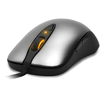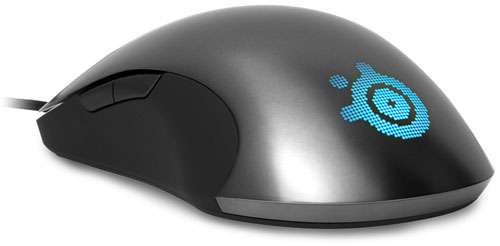- Qualcomm Launches Snapdragon 4 Gen 2 Mobile Platform
- AMD Launches Ryzen PRO 7000 Series Mobile & Desktop Platform
- Intel Launches Sleek Single-Slot Arc Pro A60 Workstation Graphics Card
- NVIDIA Announces Latest Ada Lovelace Additions: GeForce RTX 4060 Ti & RTX 4060
- Maxon Redshift With AMD Radeon GPU Rendering Support Now Available
SteelSeries Sensei Pro-Grade Gaming Mouse Review

SteelSeries takes gaming seriously, as evidenced by its high-end Xai mouse released two years ago. Developed with the help of pro gamers, the Xai boasted high-end specs, unique features and looked good. The Sensei is the Xai’s replacement, and with it comes even beefier specs, a CPU under the hood, and interesting aesthetics.
Page 4 – Final Thoughts
As far as gaming mice go, the Sensei strikes me as being one of the classier types out there. Though it includes LEDs, the focus is on performance and function, not bling. The fact that SteelSeries enlisted the help of professional gamers and their clans helped the Xai set a new bar for gaming mice, and the Sensei makes things even better.
I admit that if the internal specs were the same, I’d choose the Xai far quicker than the Sensei, but that’s all a matter of taste. The Xai is clean and simple-looking, while the Sensei is meant to stand out. The LEDs are part of the reason for that, but the reflective finish is really what makes this mouse look unique. Again, whether that’s a good thing or not is a matter of personal taste.
The Sensei offers a large number of features, many of which most gamers will never touch. I am not a pro by any means, but I did test the various functions and was impressed overall. FreeMove was one of the more interesting ones. It helps straighten your movement out when you’re moving your mouse in a “straight” line in any direction. Even in simple desktop tests, the performance of this was almost scary good.
Of all the features the Sensei (and Xai) have, the LCD menu screen on the mouse bottom is the most interesting. I could never see me using this feature ever, but I’ve talked to gamers who do see a use, or have used it themselves. Like the aesthetics of the mouse itself, the included features will not be for everyone – but it’s nice to have them nonetheless.

Things like the inaccurate LED color and clunky macro setup were a bit annoying, but minor in the grand scheme. If this mouse does something wrong, it makes up for it with a couple of other things that it does well. Alright, not just “well”, but “great”.
The Sensei is the best mouse I’ve ever used. Despite being ambidextrous, it’s comfortable – plus it’s also accurate. I played a couple of rounds of Call of Duty: Black Ops the same night I received the mouse, and was instantly impressed by how much more accurate I felt. Thinking this was some sort of giddy school-girl placebo effect, I used it over the course of a couple of weeks and my opinion hasn’t changed.
Does that mean I have become a better gamer? Not even close. That’s not to be expected, though. While I appreciate the increased accuracy, there’s more to improving your game than just getting a different gaming mouse, and that’s something SteelSeries itself acknowledges:
“Will the Sensei make you a badass 1337 n00b-owning gaming hero? Probably not, sorry. A mouse is a tool, like any other tool. Even the very best, most expensive, most amazing tennis racket in the world will not make you a better user of the tennis racket. Nothing, except your own talent and dedication will do that for you. Any company or product promising that is full of it. Period.“
A “tool” is a good way to sum up a mouse, because that’s basically what it is. If you feel more comfortable with your mouse, then gaming is going to be more enjoyable, and if you don’t need to fuss over a problem the mouse is causing you, that’s a good thing. I’ve put about 80 hours of game time into the Sensei thus far and still love it like the first day I received it. That says a lot, as I usually get bored of any peripheral after a couple of weeks.
Another plus: The Sensei uses a good sensor. Lately, 95% of gaming mice released, even high-end models, use a lackluster Philips sensor that’s prone to stalling when the mouse is picked up and sat back down. I am not sure what sensor this mouse uses, but it doesn’t suffer from issues like those.
It’d be a good time to mention that the Sensei costs $90. Sometimes, more expensive products are just worth it, and the Sensei falls into that camp. It could be better, but when it’s the best mouse I’ve ever used, it’s hard to complain about the minor issues.
- Pros
- A mouse for both right and left-handed gamers that is still comfortable.
- It doesn’t get more accurate than this.
- Features a quality sensor, unlike most gaming mice of late.
- Sufficient number of buttons, and good layout for them all.
- Flexible. Tons of tweaking-ability.
- Easy-to-use software.
- On-mouse menu is… interesting, and could be useful in some cases.
- Built with the help of professional gamers.
- Cons
- A dedicated macro profile button would have been nice.
- Annoying lock-up when a mouse setting is applied.
- LED colors are not as accurate as expected.
- Needs to be cleaned often; plastic chassis loves finger dirt.
- Pricey, at $90 USD.

SteelSeries Sensei Gaming Mouse
Discuss this article in our forums!
Have a comment you wish to make on this article? Recommendations? Criticism? Feel free to head over to our related thread and put your words to our virtual paper! There is no requirement to register in order to respond to these threads, but it sure doesn’t hurt!
Support our efforts! With ad revenue at an all-time low for written websites, we're relying more than ever on reader support to help us continue putting so much effort into this type of content. You can support us by becoming a Patron, or by using our Amazon shopping affiliate links listed through our articles. Thanks for your support!





